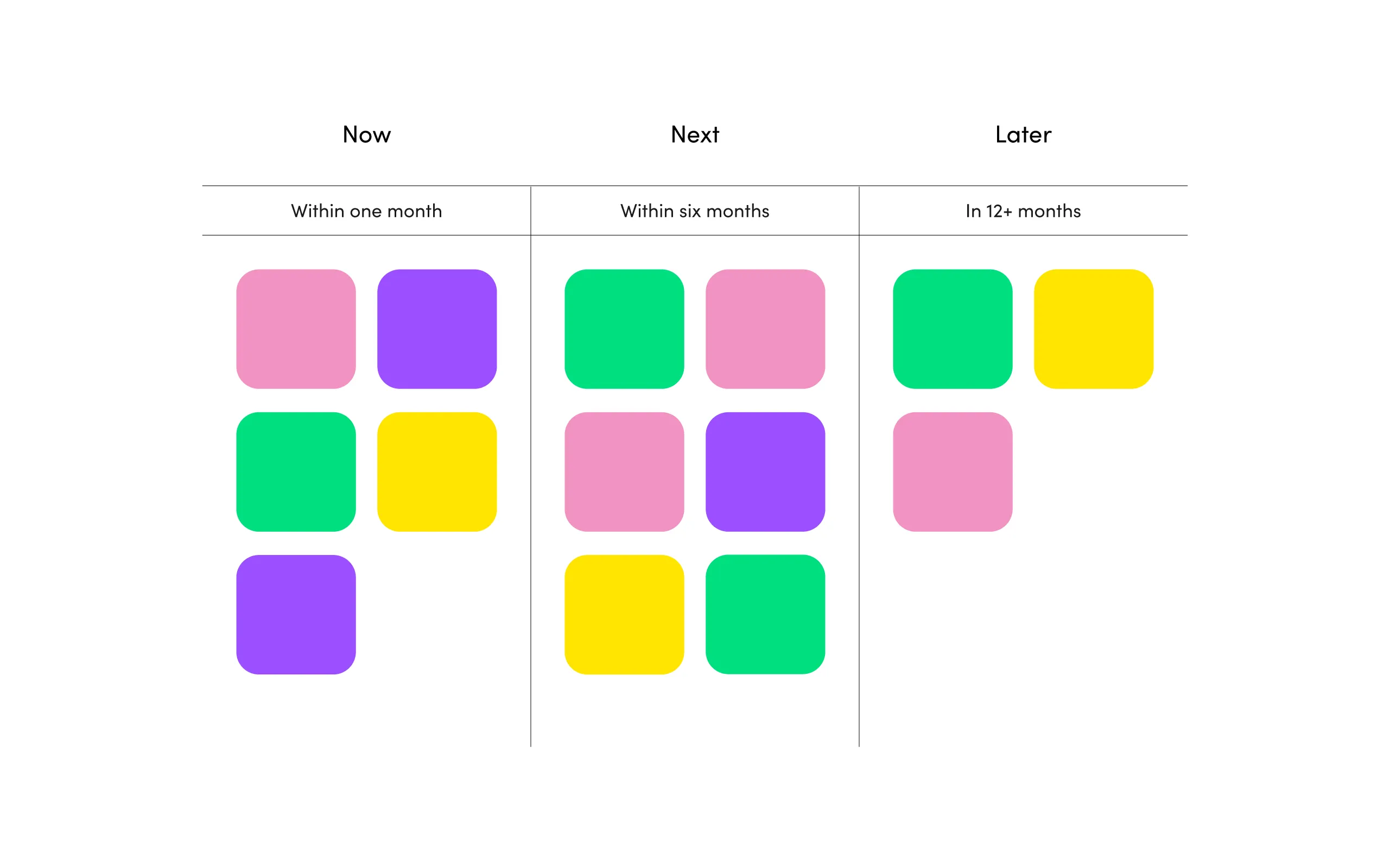How to prioritise marketing activity (and maximise ROI)

Whether you’re a multi-faceted business leader or a seasoned marketer, prioritising can be overwhelming. You want to make smart, strategic decisions – to direct energy, investment, and talent towards the work that will actually deliver results.
But when the competition is fierce and customers are bombarded with messages from all angles, how do you cut through the noise? And how do you know you’re putting your money in all the right places? Here, we’ll tell you exactly how our experts approach decision-making, so you can make confident calls that actually boost your bottom line.
Every marketing strategy should start with a why
Marketing activity isn’t just about being clever, creative, or loud. To truly stand apart and resonate with future brand advocates, you need to focus. And not just in what you communicate. Carefully selecting the right tone, platform, timing, and content type is equally key to success. But with limited hours, shrinking budgets, and a constantly growing list of channels to cover, that’s often easier said than done.
That’s why we strip it back to basics. We don’t want misguided presumptions or knee-jerk tactics to dictate how and where you direct your marketing resources. Otherwise, you risk wasting time and budget on activity that doesn’t work. Instead, we use our Think Big! research and discovery process. This paints a complete picture of your market and where your business fits within it. It helps to identify gaps, barriers and untapped opportunities through a structured blend of:
Interviews
Audience research
Competitor mapping
Performance reviews
Data-led analysis
We can then plug these opportunities to delight your audience in new ways.
Of course, it's rare to have one single priority at the end of this process. So, beyond a data-backed list of prescribed therapies, you also need to know exactly which actions to focus on first. And it’s not just about the quick wins. It’s about balancing immediate impact with long-term value. We need to pay attention to the finer details – from available resources and budget constraints to which changes will strike stronger chords with your audience.
Why prioritising marketing activity pays dividends
Prioritising marketing activity is more than a marketing hack. When every decision has a cost and every minute of your team's time matters, prioritising is an effective way to maximise impact, reduce wasted efforts, and maintain momentum. Whether you're starting from scratch, making monthly tweaks or streamlining tasks, you can:
Work smarter. Your time, people, and budget are finite. By understanding what’s achievable with the resources you have, rather than spreading focus too thin, you can channel maximum effort through a targeted selection of activities, leading to smoother workflows, more consistent output, and stronger, more measurable results.
Improve team alignment. A clear hierarchy of activity removes any guesswork, strengthens direction and encourages collaboration. This clarity also motivates employees with a sense of momentum. Expect better communication, accountability and performance.
Keep a close eye on costs. When you double down on activity that actively supports business objectives, you reduce unnecessary spend and increase returns on your investments. And, with a more focused view on performance, it’s easier to spot inefficiencies and allocate budget more strategically.
Build a stronger business case. Clear prioritisation supports clearer ROI. So, when you’re seeking additional investment from the C-suite or looking to scale a particular campaign, a clean plan changes everything. It’s easier to justify where the extra resources are going and exactly what they’re expected to deliver.
Strengthen brand positioning. Prioritising helps you show up more consistently – in the places your audience expects you to be, and in the ways that resonate most. Hit more of the right moments with a strong message, reinforcing who you are, what you stand for and why you’re the best choice.
Mastering the Boston Matrix
When it comes to prioritising marketing activity, there’s no universal checklist or silver-bullet formula. Industries vary, businesses are at different growth stages, and they'll have different goals. Likewise, their audiences are different, and resource levels can fluctuate. So, while going big and bold might reap major rewards for one brand, it might be entirely unfeasible for another.
This is why frameworks like the Boston Matrix are so valuable. Prioritising two key dimensions – impact versus effort – it works by plotting activity across four key quadrants. These quadrants identify where to double down, where to experiment, and where to revisit later. It’s not a perfect science, but it's an excellent starting point for making more objective decisions with ROI in full focus. We've also found it's what works best for our clients.
At The Bigger Boat, our quadrants look a little something like this:
Full sails. These activities are propelling your marketing forward with full force. They have the potential to deliver big results with minimal effort – some skilled input to get things up and running and light-touch adjustments to keep everything on course. These are worth prioritising for maximum impact.
Rising tides. These ideas are bubbling and have strong potential, but they may need careful attention and strategic investment to catch the wave. So, you want to pursue them, but need to be mindful about time, resources, and budgets.
Anchor points. These tactics aren’t set to make waves. Instead, they serve a steadying role that helps maintain balance and momentum. With lower predicted impact but minimal effort required, they’re perfect for grounding your schedule. Think of them as quick wins that can be slotted in without disrupting bigger initiatives.
Stowaways. They’re not expected to deliver much value right now, and may quietly drain time or budget without contributing real momentum. They can stay tucked away – but don’t forget them entirely. With the right shift in conditions, they could one day earn a rightful place on deck.
These quadrants are not set in stone. Stakeholder priorities, shifting objectives, and market conditions all influence which tactics deserve focus. So, use the matrix as a guide, but be prepared to make adjustments if something doesn’t feel quite right for your business.
For example, we work with a lot of buy-and-build businesses, where the focus is often on long-term scalability, group-wide integration, and building brand equity across a growing portfolio. In these instances, what looks like a stowaway priority on paper – such as a group rebrand or centralising subbrand websites – might become valuable sooner than expected, helping to align acquired brands, strengthen infrastructure, or lay foundations for growth.

How to create (and use) your matrix
Here’s how to create an effective prioritisation matrix:
Overview all activity. Start by gathering all the potential marketing activities you could conduct – whether they were recommended on the back of our Think Big! Research and discovery workshop findings, or generated from your own team.
Collaborate and discuss. Once you’ve collected everything, it’s time to assess and assign each activity to its appropriate quadrant. Having diverse skillsets around the table is key here. Different perspectives will help you rank activities from multiple angles. For example, while UX professionals might rank based on user impact, developers might focus on effort and feasibility.
Rank and assign. Evaluate each activity’s impact versus effort and decide where it fits in the matrix (full sails, steady course, anchor points, or stowaways). Use group consensus or voting to finalise placement.
Document the matrix. Once the matrix is finalised, document it as a clear reference point that can be easily accessed and referred back to when needed.
But don’t stop there. It’s no use ranking everything without proactively planning it into teams’ schedules. The next step is to map key findings onto a clear timeline. Use your matric to determine which activities require immediate attention, which can be revisited in six months, and which should be earmarked to come back to next year. This timeline sets the wheels in motion, holds people accountable, and ensures each activity is strategically timed and successfully executed.

Make confident moves with maximum impact
Marketing can feel overwhelming, but it doesn’t have to be. By prioritising value and goal-driven activities, you can take the guesswork out of every decision. Download our take on the Boston Matrix to start making smarter decisions with your time, budget, and resources. Or, book a Think Big! research and discovery workshop, and we’ll do the heavy lifting for you.
If you want to keep up to date with the crew, don't forget to sign up to our newsletter to benefit from digital marketing expertise, as well as exciting opportunities to improve your business' performance.
News and insights
Trust, tone, and the human touch: balancing expertise and AI in content creation
Here, we explore our belief that brand is not simply a creative exercise – it's a powerful business tool that amplifies impact – and highlight how it can be measured and proven with the right data.
Read moreNews and insights
The missing lever: why private equity brand strategy matters
Here, we explore our belief that brand is not simply a creative exercise – it's a powerful business tool that amplifies impact – and highlight how it can be measured and proven with the right data.
Read more